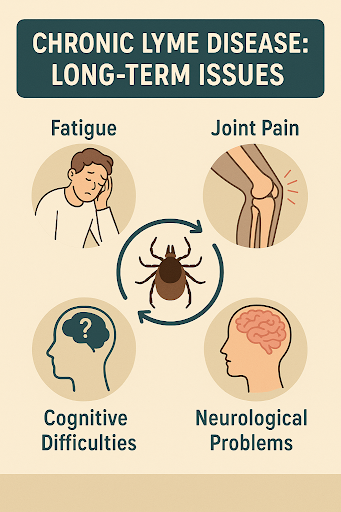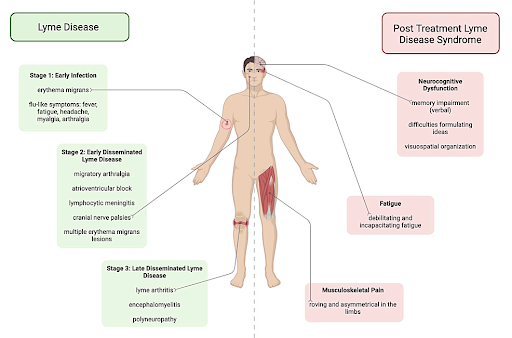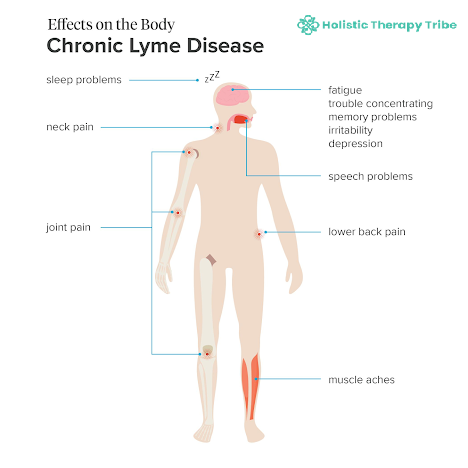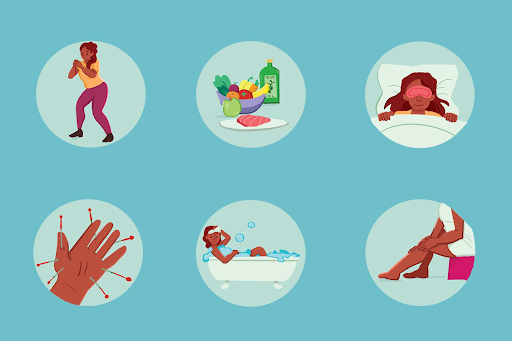
Living with Lyme disease can be difficult, but for some the problem doesn’t end after the initial treatment. However, most people recover fully with a typical course of antibiotics, but a part of a larger group suffers from persistent symptoms like – fatigue, body pain, and cognitive difficulties (also called Post Treatment Lyme Disease Syndrome PTLDS).
The exact root cause of these symptoms are unclear, and can be sometimes seen similar to other conditions, which can lead to diagnosis and treatment complex.
Reading this blog, we will find out the long term issues that are associated with Chronic Lyme Disease, also related symptoms, root causes, and managing plans for this medical condition.
Our aim is to provide clarity on PTLDS and its challenges.
Chronic Lyme Disease and PTLDS: Symptoms, Causes, and Management

Symptoms of Chronic Lyme Disease and PTLDS:
- Fatigue
- Muscle and joint pain
- Cognitive Difficulties like Brain Fog (Problem in remembering, concentration and clarity)
- Difficulty in falling asleep
- Mood swings
- Neurological symptoms like numbness, and tingling
Causes and Update :
The exact reason behind these persistent symptoms remains a topic of discussion-
- Immune response – Some experts believe that even after the infection is cleared from the body, the immune system continues to respond which is the cause of ongoing symptoms.
- Infection – And some suggest that Borrelia burgdorferi which causes Lyme disease may persist in the body in a sleeping state.
- Other reasons – There are also possibilities of co-infections, autoimmune reactions, or other underlying medical issues that can contribute to the persistent symptoms.
Management
- Managing Symptoms – Pharmacological medications to address pain, quality of sleep, and mood disorders.
- Physical Therapies – To enhance mobility and reduce pain.
- Cognitive Therapy – To improve memory and help in concentration.
- Lifestyle Changes – Nutritional balanced diet, stress reduction techniques (yoga & meditation), and daily exercises.
- Support Group – Connecting with other familiar individuals who are facing the same challenges can provide emotional support.
Long-term Effects of Chronic Lyme Disease on The Body

Physical Difficulties:
- Muscle and joint pain: This involves chronic muscle pain and joint inflammation, which limit mobility causing difficulty in daily chores. Treatments such as physiotherapy, anti-pain drugs and holistic medicines are beneficial in such cases.
- Persistent Lyme fatigue: The most difficult part of having chronic Lyme disease is chronic Lyme fatigue. One may feel drained even after resting for a long time. It can even affect the basic activities and makes it hard.
- Neurological symptoms: One may experience neurological problems such as tingling, numbness, and in some cases, facial paralysis. When the bacteria affects the nervous system these symptoms are common and may require special care and medical interventions to manage.
Cognitive and Emotional Impacts
Chronic Lyme disease not only affects the physical but also the psychological and emotional state in a profound manner. The most common cognitive symptoms are as follows.
- Loss of Memory: It includes frequent forgetting, confusion, and mental fatigue.
- Brain Fog: Sequence of thoughts that interferes the daily activities due to trouble related to attention, focusing and thinking.
- Emotional struggles: Anxiety, depression, and mood swings are common emotional effects of the disease. Mindfulness, meditation or mental health managing strategies to address these issues and enhance quality of life.
Can Lyme Disease Trigger Autoimmune Disorders?
- Rheumatoid arthritis: It is the condition that greatly affects the joints and does overlap with Lyme disease. It causes symptoms like joint pain and stiffness which makes it hard for medical professionals to diagnose and treat the disorder.
- Other autoimmune diseases: Lupus and multiple sclerosis are other autoimmune diseases that could also fall under this category as they overlap with chronic lyme disease.
The connection between Lyme Disease and Auto-Immune Disorders
Lyme disease can pinpoint autoimmune reactions in the body, which can lead to conditions that can mimic autoimmune disorders:
Managing this relation
It becomes even more serious due to autoimmune disorders, in such cases, the treatment is required for both. Addressing both conditions includes:
- Medication: Anti-inflammatory drugs, inhalation of or even the use of immunosuppressants can have a highly positive effect to avoid that reaction.
- Lifestyle changes: Making a few simple changes to your daily lives like trying to stick to a well balanced diet, involving in simple exercises. Practicing mindfulness or meditation helps in managing stress. These lifestyle changes can help you make both conditions slightly more manageable.
By addressing both Lyme disease and autoimmune responses together, individuals can improve their long-term lyme symptoms and quality of life.

Relieving Physical Pain
Appropriate coping strategies help you get relief from physical pain. Ask your doctor to suggest non-invasive procedures personalised to your health condition that are aimed at Lyme pain relief. Some of the non-invasive lifestyle procedures are as follows:
1. Non-weight bearing activities
Some of the activities like swimming, cycling, and walking are considered as low impact exercises that prevent pain and fatigue. While ensuring flexibility in the muscles and joints they aim to ensure mobility while ensuring the body is not overstressed.
2. Managing the Symptoms of Lyme Disease
Managing symptoms of Lyme disease involves managing both physical and emotional well-being. Some of the coping strategies include,
- Practicing mindfulness meditation, will help in dealing with the stress, anxiety and offering clarity in your mind while managing your pain.
- Counseling and support groups are helpful in providing comfort to the feeling while dealing with the challenges ahead.
- Whether it is art, reading books or just interacting with family, involve in a hobby that leads to mood improvement and better overall health.
Combining all these strategies helps in effective dealing of challenges with Lyme disease.
Conclusion
Chronic Lyme symptoms can impact quality of life but with effective strategies it can be managed.If you suspect prolonged symptoms of Lyme disease, consult a licensed healthcare provider for the proper care and better advice of your health condition. Accept the reality of the situation and take the support of loved ones for emotional well-being and balance. Hope to deal with challenges confidently to regain your life from these symptoms.
Reference
- CDC. Chronic Symptoms and Lyme Disease [Internet]. Lyme Disease. 2024. [CDC]
- Global Lyme Alliance. Decoding Chronic Lyme: Investigating Epigenetic Signatures [Internet]. Global Lyme Alliance.org. 2025 [GLA]
- LymeCare Alliance. Chronic Lyme Disease and Post-Treatment Lyme Disease Syndrome (PTLDS): Controversies and Care. Lymecare.org. LymeCare Alliance; 2024 [cited 2025 Apr 24]. [LCA]
- Alliance GL. How Does Lyme Disease Affect the Immune System?. www.global lyme alliance.org. 2024. [GLA]
- Writer. Coping with Lyme Disease Flares: Tips for Managing Symptom Exacerbations. Global Lyme Alliance.org. 2024 [cited 2025 Apr 3]. [GLA]







